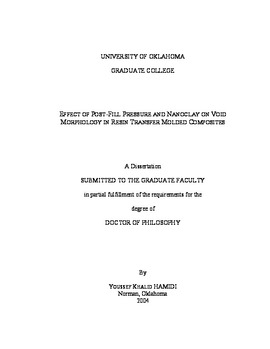| dc.contributor.advisor | Altan, M. C., | en_US |
| dc.contributor.author | Hamidi, Youssef Khalid. | en_US |
| dc.date.accessioned | 2013-08-16T12:19:32Z | |
| dc.date.available | 2013-08-16T12:19:32Z | |
| dc.date.issued | 2004 | en_US |
| dc.identifier.uri | https://hdl.handle.net/11244/794 | |
| dc.description.abstract | Resin transfer molded (RTM) composites usually suffer from the formation of flow-induced defects such as voids. Detrimental effects of voids on performance of molded parts have been studied extensively. Yet, knowledge of effective void removal strategies, along with detailed morphological void distribution within molded composites is very limited. In this investigation, effects of post-fill pressure on void content is investigated for random-mat, E-glass/epoxy RTM disks. Measured void contents agree well with results obtained in other studies for similar ranges of modified capillary number values. Packing helped significantly reduce void contents in RTM parts. In addition, voids are found to concentrate primarily within or adjacent to the fibers. Three-dimensional features of the formed voids are included in more detailed analyses of morphology variations of voids within the composite from both through-the-thickness and planar surfaces. | en_US |
| dc.description.abstract | Effects of applying a packing pressure on void morphology are investigated for similar composites. Packing pressures of zero and 570 kPa are applied and voidage is evaluated from both through-the-thickness and planar views. The packed composite is found to contain almost 92% less void content than the unpacked composite, accompanied by a 40% drop in average void size. Along the flow direction, removal of voids seems to depend on their arrangement at the end of the filling stage. | en_US |
| dc.description.abstract | Finally, effect of nanoclay content on void morphology in RTM nanoclay/E-glass/epoxy composites are investigated. ClositeRTM25A nanoclay loads of 0, 2, 5, and 10 wt% are mixed with a low-viscosity epoxy resin prior to filling. Void occurrence is observed to increase considerably with increasing nanoclay content from 2.1% in the composite without nanoclay to 5.1 and 8.3% in 5%- and 10%-nanocomposites, respectively. However, the composite with 2 wt% nanoclay yields the lowest void content of 0.7%. Voids are observed to be smaller after the addition of nanoclay at all concentrations. | en_US |
| dc.format.extent | xii, 274 leaves : | en_US |
| dc.subject | Engineering, Materials Science. | en_US |
| dc.subject | Composite materials. | en_US |
| dc.subject | Engineering, Mechanical. | en_US |
| dc.subject | Engineering, Chemical. | en_US |
| dc.subject | Thermoplastics. | en_US |
| dc.subject | Plastics Molding. | en_US |
| dc.title | Effect of post-fill pressure and nanoclay on void morphology in resin transfer molded composites. | en_US |
| dc.type | Thesis | en_US |
| dc.thesis.degree | Ph.D. | en_US |
| dc.thesis.degreeDiscipline | School of Aerospace and Mechanical Engineering | en_US |
| dc.note | Source: Dissertation Abstracts International, Volume: 65-09, Section: B, page: 4788. | en_US |
| dc.note | Adviser: M. C. Altan. | en_US |
| ou.identifier | (UMI)AAI3148880 | en_US |
| ou.group | College of Engineering::School of Aerospace and Mechanical Engineering | |
